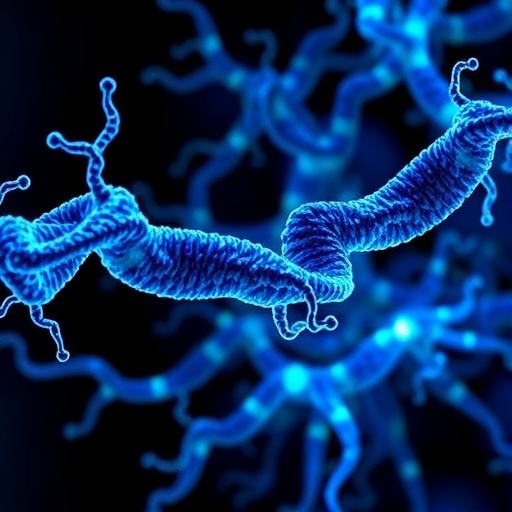In a breakthrough study poised to reshape our understanding of Parkinson’s disease pathology, researchers have unveiled a critical molecular mechanism underlying the secretion of α-synuclein in the mouse striatum. This mechanistic insight centers on the pivotal role of N-type calcium (Ca^2+) channels in mediating stimulus-dependent release of α-synuclein, a protein intricately linked with neurodegenerative processes. The findings, recently published in npj Parkinson’s Disease, open new avenues for therapeutic targeting aimed at modulating pathological α-synuclein spread, a hallmark in the progression of synucleinopathies.
α-Synuclein, a presynaptic neuronal protein, has long been recognized as a central player in Parkinson’s disease due to its propensity to aggregate into toxic fibrils that contribute to neuronal dysfunction and death. However, the processes regulating its secretion, particularly in response to neuronal activity, remained obscure until now. The research team, led by Leandrou, Chalatsa, and Vekrellis, employed sophisticated molecular biology tools combined with in vivo electrophysiological techniques to unravel how N-type voltage-gated Ca^2+ channels act as key gatekeepers in calcium-mediated α-synuclein release in the mouse striatum.
The significance of the striatum in Parkinson’s pathology is well documented; it is heavily innervated by dopaminergic neurons and is a primary site of α-synuclein accumulation. By focusing on the striatum, the scientists could observe physiological secretion dynamics of α-synuclein related to neuronal activity and how N-type Ca^2+ channels translate electrical stimuli into biochemical signals. This translation is essential for synaptic vesicle exocytosis, which they now implicate as a critical step in α-synuclein dispersal beyond traditional synaptic boundaries.
Central to their findings is the observation that selective blockade of N-type Ca^2+ channels significantly reduces stimulus-induced release of α-synuclein without affecting other calcium channel subtypes. This specificity underscores the unique role of these channels in pathological yet activity-dependent secretion mechanisms. Such data suggest that N-type channel inhibitors might reduce extracellular α-synuclein propagation in vivo, potentially mitigating the spread of toxic protein aggregates through the brain’s neuronal networks.
The investigators also utilized optogenetics to finely tune neuronal stimulation, allowing them to dissect the temporal precision of Ca^2+ influx and consequent α-synuclein secretion. This approach provided robust evidence that α-synuclein release is not simply a byproduct of neuronal damage but a tightly regulated, stimulus-dependent process mediated through N-type calcium channels. This challenges previous paradigms which primarily associated α-synuclein release with passive leakage from dying neurons.
Moreover, using advanced imaging techniques, the team visualized vesicular exocytosis events coincident with Ca^2+ channel activation, confirming the dependence of α-synuclein release on synaptic vesicle neurotransmission machinery. This finding bridges the gap between calcium channel physiology and pathogenic protein secretion, suggesting that α-synuclein hijacks canonical synaptic mechanisms for its intercellular spread.
Another groundbreaking aspect of the study lies in the potential therapeutic implications. Current Parkinson’s interventions largely focus on dopamine replacement but fail to address underlying disease progression driven by proteinopathy. Targeting N-type Ca^2+ channels may offer a novel way to halt or slow disease propagation by preventing α-synuclein’s extracellular transfer, thus preserving neuronal integrity and function.
Importantly, the researchers also assessed the specificity of Ca^2+ channel involvement by examining L-type and P/Q-type channels, which yielded minimal impact on α-synuclein secretion. This pharmacological distinction enriches our understanding of calcium channel diversity in neuronal signaling and underlines the necessity of precision medicine approaches tailored to distinct molecular pathways.
The study additionally sheds light on the interplay between neuronal activity, calcium signaling, and α-synuclein pathology, elucidating a fundamental aspect of synaptic biology with direct relevance to neurodegeneration. It suggests that aberrant neuronal firing patterns could exacerbate α-synuclein secretion, potentially accelerating disease progression, thereby highlighting the importance of modulating neuronal excitability in therapeutic strategies.
On a molecular level, the interaction between α-synuclein and the synaptic vesicle cycle emerges as a critical factor governing its extracellular presence. The dynamics of this interplay are likely influenced by the sustained opening of N-type Ca^2+ channels, which orchestrate vesicle fusion events and neurotransmitter release, now implicated in pathogenic α-synuclein dissemination.
Future research stemming from these results may explore whether blocking N-type Ca^2+ channels can alleviate α-synuclein-related toxicity in animal models and whether similar mechanisms are conserved across different brain regions and in human pathology. Such translational studies could pave the way toward clinical trials evaluating calcium channel modulators as disease-modifying agents in Parkinson’s disease.
These findings resonate with a broader effort to decode mechanisms of protein aggregation diseases and affirm the utility of neurophysiological tools combined with molecular biology to dissect complex neurodegenerative phenomena. The integration of electrophysiology, pharmacology, and imaging in this study sets a new standard for mechanistic neuroscience and offers fresh hope for interrupting pathogenic protein transmission in brain disorders.
In conclusion, the elucidation of N-type Ca^2+ channels as mediators of α-synuclein secretion in the striatum marks a transformative advance in Parkinson’s disease research. By delineating how neuronal stimuli harness calcium influx via these specific channels to promote extracellular α-synuclein dynamics, the study opens promising avenues for developing therapeutic interventions that could retard or prevent disease progression. This mechanistic clarity underscores the importance of targeting synaptic physiology in the fight against devastating neurodegenerative diseases.
Subject of Research: Mechanistic role of N-type Ca^2+ channels in stimulus-dependent α-synuclein secretion in the mouse striatum related to Parkinson’s disease pathology.
Article Title: N-type Ca^2+ channels mediate the stimuli-dependent α-synuclein secretion in mouse striatum.
Article References:
Leandrou, E., Chalatsa, I., Vekrellis, K. et al. N-type Ca^2+ channels mediate the stimuli-dependent α-synuclein secretion in mouse striatum. npj Parkinsons Dis. 11, 276 (2025). https://doi.org/10.1038/s41531-025-01110-z
Image Credits: AI Generated




